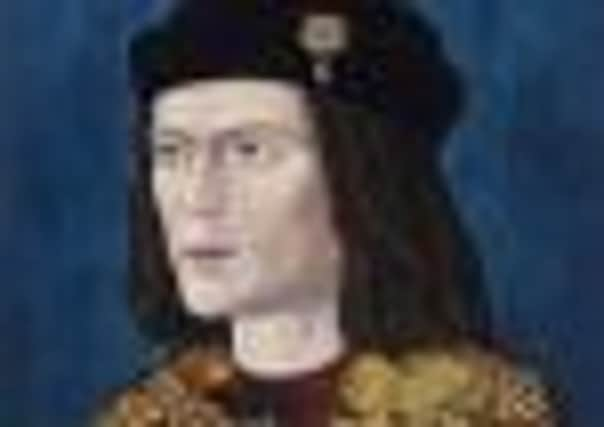‘Yorkshire king’ could be brought back after 500 years


Mystery has since surrounded the site of his Leicester grave since the location of Greyfriars church, where he was reportedly buried, became clouded after 500 years of development.
But after a potentially ground- breaking archaeological find in the Midlands city, the remains of the king may have been found and calls for him to be buried at York Minster, which was his own wish, are mounting.
Advertisement
Hide AdAdvertisement
Hide AdRichard, the last Plantagenet king, had strong links with the county, spending much of his youth at Middleham Castle, in Wensleydale, and ruling the North of England on behalf of King Edward IV for 12 years.
Although he was entitled a burial at Westminster Abbey alongside other kings and queens of England, he announced his intention to be buried in York and set out plans for a new chantry chapel at York Minster in 1483.
With speculation mounting over a state funeral, the Richard III Foundation, a non-profit organisation promoting understanding of the king’s life and times, is bidding for the remains to be returned to York.
Joe Ann Ricca, founder and chief executive of the foundation, said: “Richard obviously had no choice after he was killed as to where his remains were taken, but today we have the opportunity to right the many wrongs that have been done to this unjustly maligned king, by correcting the distorted picture that has been painted of Richard over the centuries, and by bringing his remains home to Yorkshire, and to York Minster as he wanted.”
Advertisement
Hide AdAdvertisement
Hide AdIt was revealed last week that an archaeological dig in a council car park in Leicester had unearthed a skeleton with a metal arrow in its back that could be the remains of the medieval monarch.
The skeleton, found by experts from the University of Leicester, has a curved spine and appears to have had trauma to the skull at or near the time of death.
London furniture maker Michael Ibsen, a descendant of the king’s eldest sister Anne of York, has visited the dig and is having a sample of his DNA compared with that of the skeleton to verify whether it is indeed the king.
Andy Smith, the foundation’s UK public relations director, added: “York was Richard’s city. It is where he belongs, and it is only right that this great Lord of the North should return home to Yorkshire after more than 500 years’ enforced absence.
Advertisement
Hide AdAdvertisement
Hide Ad“The Richard III Foundation urges the people of Yorkshire to join with us in calling for Richard, our hero and martyr, to be brought home to the city that he loved, and where he is still loved to this day.”
Indeed, so strongly was Richard linked to York that city authorities greeted the news of his death at the Battle of Bosworth by stating: “King Richard, late mercifully reigning over us, was, through great treason, piteously slain and murdered, to the great heaviness of this city”.
Conservative MP and historian Chris Skidmore has already waded in, suggesting that if the remains are authenticated a full state funeral should lay Richard to rest in Westminster Abbey, alongside his queen, Anne Neville, or in York Minster.
Mr Skidmore has tabled a Commons early day motion calling for a state funeral for the king if the remains are verified.
Advertisement
Hide AdAdvertisement
Hide AdModern views of the much-maligned monarch have been heavily influenced by Shakespeare’s portrayal of him and the mystery of the princes in the tower – the young Edward V and his brother, whom Richard is assumed to have had murdered.
The Richard III Foundation will hold a conference at Market Bosworth, in Leicestershire, entitled Richard III: Monarch and Man on October 13, from 8.30am to 5pm.
Speakers at the conference will include actor, historian and author Robert Hardy.
The conference will be preceded on October 12 by a tour of the battlefield site at Bosworth, led by historian Mike Ingram, author of a new book on the battle.
Visit www.richard111.com for further information.